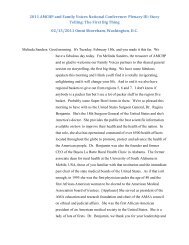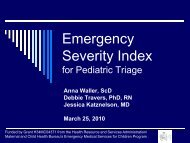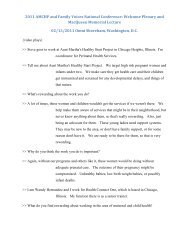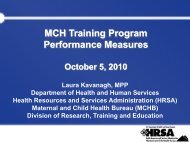Hormone Disruptors and Women's Health: Reasons for Concern [PDF]
Hormone Disruptors and Women's Health: Reasons for Concern [PDF]
Hormone Disruptors and Women's Health: Reasons for Concern [PDF]
You also want an ePaper? Increase the reach of your titles
YUMPU automatically turns print PDFs into web optimized ePapers that Google loves.
Women’s Reproductive <strong>Health</strong> <strong>Concern</strong>s<br />
Animal studies designed to predict human harm, as well as a limited number of human studies, have helped researchers underst<strong>and</strong><br />
some of the ways hormone disruptors can increase risk <strong>for</strong> various health problems. More research is needed, but below are descriptions<br />
of some of these health problems <strong>and</strong> examples of associated hormone disruptors (in italics).<br />
Early puberty is a growing concern. In<br />
the U.S. girls get their first periods a few<br />
months earlier than they did 40 years<br />
ago, <strong>and</strong> they develop breasts one to<br />
two years earlier. Early puberty has<br />
been associated with polycystic ovarian<br />
syndrome, obesity, breast cancer,<br />
depression <strong>and</strong> a number of social challenges<br />
such as experimentation with<br />
sex, alcohol or drugs at a younger age.<br />
Phthalates, BPA, some pesticides such as<br />
DDT, PCBs, PBBs, cigarette smoke <strong>and</strong><br />
DES.<br />
Impaired fertility or infertility<br />
includes difficulty or the inability to get<br />
pregnant <strong>and</strong>/or carry a pregnancy to<br />
term. It is difficult to say <strong>for</strong> certain how<br />
many people experience impaired fertility,<br />
but the best estimate is 12% of the<br />
reproductive age population in the U.S.<br />
This number seems to have increased<br />
over the last two decades, most sharply<br />
in women under the age of 25. Menstrual<br />
irregularities <strong>and</strong> male infertility<br />
contribute to this problem, as well as<br />
other specific health concerns, which<br />
are listed below. DDT, cigarette smoke,<br />
phthalates <strong>and</strong> PCBs.<br />
Polycystic ovarian syndrome (PCOS)<br />
symptoms include irregular periods, pelvic<br />
pain <strong>and</strong> ovarian cysts. Women with<br />
PCOS have a higher risk of developing<br />
insulin resistance, diabetes, endometrial<br />
cancer, infertility, miscarriage <strong>and</strong><br />
hypertension. BPA.<br />
Uterine fibroids occur in 25% to 50%<br />
of all women, though some estimates<br />
are much higher. Fibroids are the number<br />
one cause of hysterectomy in reproductive<br />
age women <strong>and</strong> can cause pelvic<br />
pain, abnormally heavy periods, abnormal<br />
uterine bleeding, infertility <strong>and</strong> complications<br />
in pregnancy. DES <strong>and</strong> BPA.<br />
Endometriosis occurs when the tissue<br />
that lines the inside of the uterus (called<br />
the endometrium) grows outside the<br />
uterus on other parts of the body, <strong>for</strong><br />
example the ovaries, abdomen <strong>and</strong> pelvis.<br />
Estimates vary, but most studies find<br />
between 10% <strong>and</strong> 15% of reproductiveage<br />
women have endometriosis. About<br />
30% to 40% of women with endometriosis<br />
are infertile, making it one of the<br />
leading contributors to female infertility.<br />
DES, dioxins, phthalates <strong>and</strong> PCBs.<br />
Miscarriage affects up to 21% of<br />
known pregnancies <strong>and</strong> can be caused<br />
by a variety of factors, especially abnormal<br />
chromosomes (known as aneuploidy).<br />
BPA, cigarette smoke <strong>and</strong> pesticides<br />
such as DDT.<br />
Shortened lactation, or reducing<br />
how long a woman can breastfeed her<br />
baby, can have longterm impacts on<br />
the child, including increased risk <strong>for</strong><br />
infection, chronic disease, compromised<br />
immunity <strong>and</strong> obesity. Breastfeeding<br />
helps build a child’s immune system<br />
<strong>and</strong> later intelligence <strong>and</strong> is important<br />
to the bonding <strong>and</strong> nurturing process.<br />
PCBs <strong>and</strong> pesticides such as Atrazine or<br />
DDT/DDE.<br />
Breast cancer incidence rates in the<br />
United States increased by more than<br />
40% between 1973 <strong>and</strong> 1998. In 2008, a<br />
woman’s lifetime risk of breast cancer<br />
is one in eight. More than 200 chemicals,<br />
including numerous hormone<br />
disruptors, have been associated with<br />
increased incidence of breast tumors.<br />
DES, BPA, first- or second-h<strong>and</strong> smoke <strong>and</strong><br />
some pesticides, especially early life exposure<br />
to DDT.<br />
<strong>Hormone</strong> <strong>Disruptors</strong> <strong>and</strong> Men’s<br />
<strong>Health</strong>. This report focuses on the risks<br />
of hormone disruptors <strong>and</strong> women’s<br />
health, but these chemicals also pose<br />
risks to males, especially from exposures<br />
in the womb. Some of these risks include<br />
hypospadias (a birth defect of the penis),<br />
cryptochordism (undescended testicles),<br />
impaired fertility from reduced sperm<br />
count <strong>and</strong> semen quality, <strong>and</strong> some<br />
cancers, including testicular <strong>and</strong> prostate<br />
cancer.<br />
<strong>Hormone</strong> disruptors are not the only<br />
type of chemicals that can harm women’s<br />
health. Solvents, air pollution, heavy<br />
metals such as lead <strong>and</strong> mercury <strong>and</strong><br />
many other contaminants can harm<br />
people’s health. To learn about other<br />
environmental contaminants, see the<br />
references at the end of this brochure.


![Hormone Disruptors and Women's Health: Reasons for Concern [PDF]](https://img.yumpu.com/19410002/4/500x640/hormone-disruptors-and-womens-health-reasons-for-concern-pdf.jpg)













